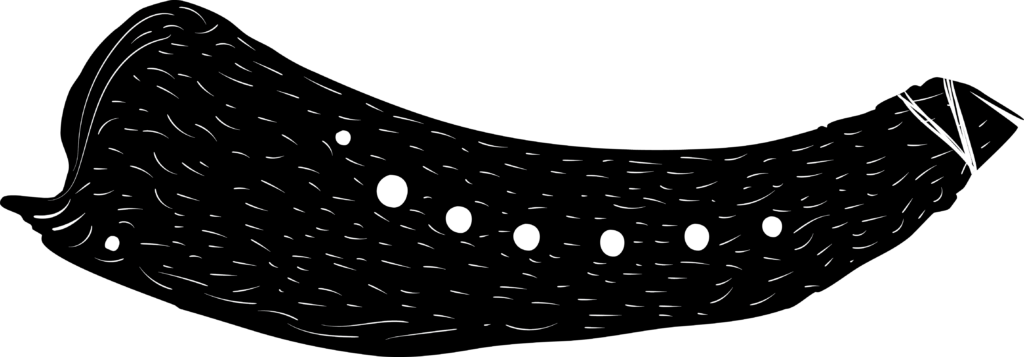The Meråker clarinet is a type of folk clarinet that was especially used in Meråker in Trøndelag, and is probably the only clarinet that has survived to our time. Locally, the instrument was originally called a "flute," even though its construction more closely resembles a simple clarinet than a flute. The instrument belongs to a small and fragmented family of shepherd clarinets that have been used in Norway: the Volla clarinet from Oppdal and the Østerdalen clarinet that appeared at the Glomdals Museum in Elverum.
The traditional Meråker clarinet was made by taking two hollowed-out halves of wood that were fastened together and placed in water until they swelled. This approach is very similar to the making of wooden lurs, which points to a relationship between these instruments. Then the end was trimmed, a small plug attached, and a wooden splinter of juniper was tied to the blowing end – similar to a reed horn. Finally, eight finger holes and one thumb hole were cut or drilled on the underside. The construction shows clear similarities to other folk clarinet-like instruments in the Nordic countries, such as the Finnish "mänkeri."
The Meråker clarinet was primarily a herding instrument that was made and played by shepherds and young people in Stordalen. In the first decades of the 1900s, the instrument fell more and more out of use, which was connected to the strong decline in traditional summer farming. As with many other traditional utility instruments, there was a danger that the knowledge of making and playing the Meråker clarinet would disappear completely.
In the mid-1950s, workers at the smelting plant in Kopperå had the idea to revive the tradition of making such shepherd clarinets. Harald Gilland (1912-1992), who in his youth had learned to make such clarinets from his father, and who was also a skilled fiddler, took on the task. This became the start of a new era for the Meråker clarinet.

Gilland gradually changed the manufacturing method of the clarinet and adapted the instrument to a more modern time. The modernised Meråker clarinet was turned from just one piece of wood, preferably hard birch. Then the instrument received a flat reed bed, was lacquered with plastic varnish, and equipped with a B-clarinet reed, which he had thinned out in advance. The reed was attached to the blowing end using a copper wire or hose clamps.
Gilland made his clarinets mainly in two different lengths with A and B as the root notes, but also made a few clarinets tuned in G. The number of finger holes was still eight holes on the top and one thumb hole on the bottom. With this modernised version of the Meråker clarinet, the instrument could be more easily played together with other instruments and became more versatile in use.
In the early 1970s, Gilland formed a trio with the fiddler Svend Gravåsen and the guitarist Olaf Tideman. At the same time, he transferred many of his old fiddle tunes from the village of Stordalen to the clarinet, including several springar dances.
After Harald Gilland died in 1992, the building of Meråker clarinets in the village was continued by Nils Underhaug, who learned the art directly from Gilland. In addition, the instrument maker Magnar Storbækken (1956-2022) from Tolga in Nord-Østerdal developed his own variant of the Meråker clarinet.
Østerdalsklarinetten (The Østerdalen Clarinet)
At the Glomdals Museum in Elverum, there is a closely related instrument to the Meråker clarinet that is often referred to as the Østerdalen clarinet. The museum lacks background information about the instrument, beyond that it is registered as a "flute" probably in 1911 and that it likely comes from Østerdalen. This instrument is about 50 cm long and consists of two half-splits that are hollowed out and tied together again with birch bark. At one end, a mouthpiece is formed, and at the other end, there is a diagonally cut mouthpiece with traces of wrapping with thread, probably for the purpose of attaching a splinter. On the top, the instrument is equipped with 7 approximately equal-sized finger holes, placed at about equal distances from each other.
In recent years, the Meråker clarinet has found its place as a valuable element in the Norwegian folk music tradition. The instrument represents a unique fusion of different instrument traditions: it has features from both the wooden lur, the reed horn, and other shepherd clarinets. At the same time, the modernisation of the instrument has made it possible to include it in a wider range of musical contexts.
Further reading:
2023 - Bjørn Aksdal – Klarinettinstrumenter i norske folkemusikk
1993 - Atle Lien Jenssen - Østerdalsklarinetten - et glemt tradisjonsinstrument?
1992 - Bjørn Aksdal – Meråker Clarinet
Buy a Meråker clarinet?
Are you interested in buying a Meråker clarinet, or have any questions regarding the instrument?
Send me an email through the contact form:


